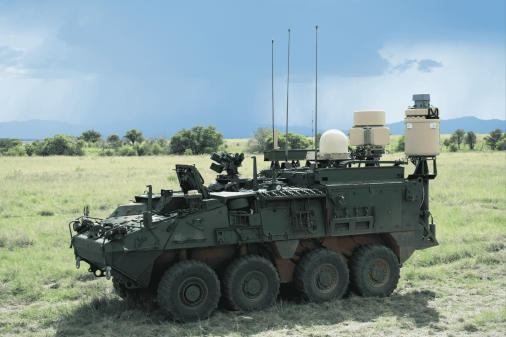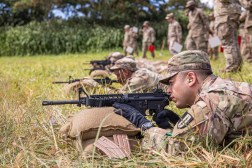Army lesson from Ukraine war: cyber, EW capabilities not decisive on their own
AUGUSTA, Ga. — One of the key observations the U.S. Army is taking from the war in Ukraine is that non-kinetic capabilities such as cyber and electronic warfare must be combined with other weapons in order to achieve their full potential on the battlefield.
“The conflict also reveals an important aspect of both EW and cyber: neither is dominant on its own and they work best when converged with other multi-domain effects,” Lt. Gen. Maria Gervais, deputy commanding general and chief of staff at Training and Doctrine Command, said during a presentation at the TechNet Augusta conference on Tuesday.
For example, “the ability to use EW to detect an adversary is most formidable when matched with a long-range precision fires,” Gervais said.
Some non-kinetic technologies can be effective as standalone tools for so-called “gray zone” competition, which takes place below the threshold of armed conflict. But in a full-on conflict, these capabilities must be part of a combined arms approach, U.S. military leaders say. That’s a message they’ve been underscoring for years, but it has been reinforced by what they’re seeing in the ongoing Ukraine-Russia war.
The Army has been working to tie its non-kinetic capabilities to be able to sense and detect enemy forces at greater distances and cue long-range missiles.
In 2014, during an earlier incursion into Ukraine, Russia demonstrated the ability to geo-locate Ukrainian units based upon their electromagnetic signatures and then target them with missiles. This revelation was a bit of a wakeup call for the U.S. Army, leading it to change many of its tactics and become much more dynamic in constantly moving units and reducing the signatures of its command posts.
Gervais noted that cyber has been a nuisance for Russia in its most recent operations in Ukraine, saying it has been unable to converge cyber effects with other warfighting domains, which has limited their utility.
Other outside experts have shared this overall assessment.
“It is unsurprising that EW has demonstrated relatively more utility as the conflict has dragged on,” Gavin Wilde, senior fellow for technology and international affairs at the Carnegie Endowment for International Peace and a former official on the National Security Council, told FedScoop. “It does appear that Russia’s cyber and EW capabilities have, on their own, proven insufficient to achieve significant gains on the battlefield.”
“However, relative to the initial incursion, there are some indications that Russian EW has come to be more decisive in augmenting the overwhelming artillery advantage they have against the Ukrainian forces along the lines of contact in Donbas and to the south. There have been far fewer, if any, examples of ‘lessons learned’ or any kind of ‘re-emergence’ of cyber capabilities in support of kinetic action since late February,” he added.
Gervais did point to successful use cases where Russian electronic warfare brigades have detected Ukrainian artillery positions based upon radio transmissions, and jammed Ukrainian drones and GPS signals.
However, these jamming tactics have been indiscriminate, affecting areas outside the conflict zone, Gervais said, from Finland to the Black Sea — even forcing a Finnish airline to cancel flights.
Wilde also noted that in his assessment, Russia’s “information troops,” which are often construed in the West as a rough analog to U.S. Cyber Command, are likely more staffed and optimized for counter-propaganda and information operations as opposed to offensive cyber and combined arms.
However, these non-kinetic capabilities can still have important effects on the battlefield, and Gervais noted the Army must develop a resilient unified network to withstand electronic feints.
“Now both EW and cyber have played major roles in the fighting in Ukraine. It demonstrates the types of threat the unified network will face in conflict with a peer or a near-peer adversary,” she said. “The unified network will need to operate in an environment where it will face significant challenges from EW and cyber. It must be resilient enough to handle these threats while providing the Army and the joint force the speed and relevancy to converge multi-domain effects against an adversary. Ukraine serves as a stark reminder of this challenge.”
The unified network, the vision for connecting tactical and strategic networks, must also enable U.S. forces to make decisions much faster in this dynamic environment.
Today, the pace of decision-making and operations are too slow. Gervais noted that Ukraine has had success in how it’s been able to use commercial technologies — such as citizens with smartphones and personal drones — to collect intelligence on Russian forces and pass that information to Ukrainian forces that can use it for targeting.
“If we tried to do something like that [with intelligence information] … ours would have to go all the way back to the [National Geospatial-Intelligence Agency], would have to be compared to some level of data before we could ever target off that information. I want you to think about that. And when speed is of the essence, any delay could be the true measure between winning and losing,” she said.
“The unified network is the critical enabler to the success of the future force and it requires our continuous attention. As the pace of technological advances occur, if not addressed, [it] will dramatically erode the overmatch advantage that we have enjoyed for ages,” she added.
Gervais’ stark message for the audience was that in future conflicts, the force that can sense the quickest; process and analyze data using artificial intelligence, machine learning and tactical edge computing; and then distribute that information the fastest to various weapon systems, kinetic or non-kinetic, will win.






